Related Research Articles
Abstract expressionism in the United States emerged as a distinct art movement in the immediate aftermath of World War II and gained mainstream acceptance in the 1950s, a shift from the American social realism of the 1930s influenced by the Great Depression and Mexican muralists. The term was first applied to American art in 1946 by the art critic Robert Coates. Key figures in the New York School, which was the center of this movement, included such artists as Arshile Gorky, Jackson Pollock, Franz Kline, Mark Rothko, Norman Lewis, Willem de Kooning, Adolph Gottlieb, Clyfford Still, Robert Motherwell, Theodoros Stamos and Lee Krasner among others.

Richard Diebenkorn was an American painter and printmaker. His early work is associated with abstract expressionism and the Bay Area Figurative Movement of the 1950s and 1960s. In the late 1960s he began his extensive series of geometric, lyrical abstract paintings. Known as the Ocean Park paintings, these paintings were instrumental to his achievement of worldwide acclaim. Art critic Michael Kimmelman described Diebenkorn as "one of the premier American painters of the postwar era, whose deeply lyrical abstractions evoked the shimmering light and wide-open spaces of California, where he spent virtually his entire life."
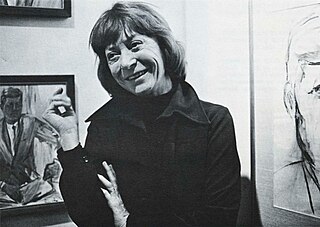
Elaine Marie Catherine de Kooning was an Abstract Expressionist and Figurative Expressionist painter in the post-World War II era. She wrote extensively on the art of the period and was an editorial associate for Art News magazine.

Color field painting is a style of abstract painting that emerged in New York City during the 1940s and 1950s. It was inspired by European modernism and closely related to abstract expressionism, while many of its notable early proponents were among the pioneering abstract expressionists. Color field is characterized primarily by large fields of flat, solid color spread across or stained into the canvas creating areas of unbroken surface and a flat picture plane. The movement places less emphasis on gesture, brushstrokes and action in favor of an overall consistency of form and process. In color field painting "color is freed from objective context and becomes the subject in itself."
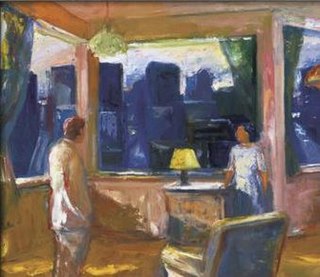
Elmer Nelson Bischoff, was an American visual artist, from the San Francisco Bay Area. Bischoff, along with Richard Diebenkorn and David Park, was part of the post-World War II generation of artists who started as abstract painters and found their way back to figurative art.
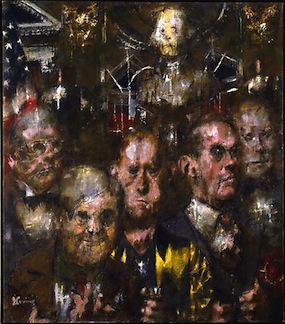
Jack Levine was an American Social Realist painter and printmaker best known for his satires on modern life, political corruption, and biblical narratives. Levine is considered one of the key artists of the Boston Expressionist movement.
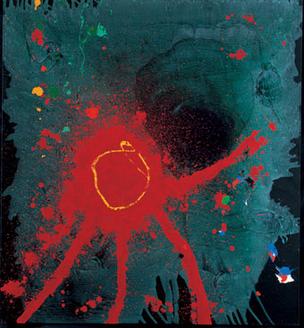
Lyrical abstraction is either of two related but distinct trends in Post-war Modernist painting:
The Bay Area Figurative Movement was a mid-20th-century art movement made up of a group of artists in the San Francisco Bay Area who abandoned working in the prevailing style of Abstract Expressionism in favor of a return to figuration in painting during the 1950s and onward into the 1960s.
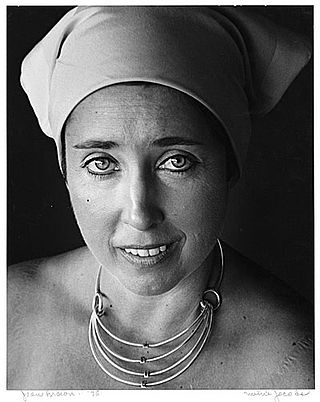
Joan Brown was an American figurative painter who lived and worked in Northern California. She was a member of the "second generation" of the Bay Area Figurative Movement.
Harvey Dinnerstein was an American figurative artist and educator. A draftsman and painter in the realistic tradition, his work included genre paintings, contemporary narratives, complex figurative compositions, portraits, and intimate images of his family and friends.

Jack Zajac is a Californian West Coast artist who has been concerned with the “Romantic Surrealist tradition”.
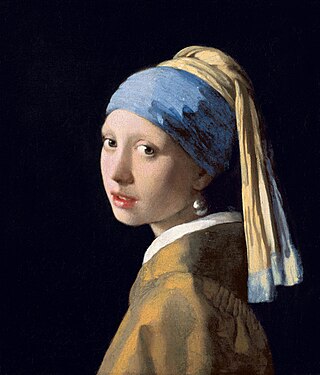
The history of Western painting represents a continuous, though disrupted, tradition from antiquity until the present time. Until the mid-19th century it was primarily concerned with representational and traditional modes of production, after which time more modern, abstract and conceptual forms gained favor.

New York Figurative Expressionism is a visual arts movement and a branch of American Figurative Expressionism. Though the movement dates to the 1930s, it was not formally classified as "figurative expressionism" until the term arose as a counter-distinction to the New York–based postwar movement known as Abstract Expressionism.

20th-century Western painting begins with the heritage of late-19th-century painters Vincent van Gogh, Paul Cézanne, Paul Gauguin, Georges Seurat, Henri de Toulouse-Lautrec, and others who were essential for the development of modern art. At the beginning of the 20th century, Henri Matisse and several other young artists including the pre-cubist Georges Braque, André Derain, Raoul Dufy and Maurice de Vlaminck, revolutionized the Paris art world with "wild", multi-colored, expressive landscapes and figure paintings that the critics called Fauvism. Matisse's second version of The Dance signified a key point in his career and in the development of modern painting. It reflected Matisse's incipient fascination with primitive art: the intense warm color of the figures against the cool blue-green background and the rhythmical succession of the dancing nudes convey the feelings of emotional liberation and hedonism.

American Figurative Expressionism is a 20th-century visual art style or movement that first took hold in Boston, and later spread throughout the United States. Critics dating back to the origins of Expressionism have often found it hard to define. One description, however, classifies it as a Humanist philosophy, since it is human-centered and rationalist. Its formal approach to the handling of paint and space is often considered a defining feature, too, as is its radical, rather than reactionary, commitment to the figure.
Julius Hatofsky was an American painter.
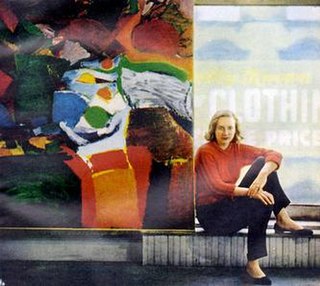
Grace Hartigan was an American abstract expressionist painter and a significant member of the vibrant New York School of the 1950s and 1960s. Her circle of friends, who frequently inspired one another in their artistic endeavors, included Jackson Pollock, Larry Rivers, Helen Frankenthaler, Willem and Elaine de Kooning and Frank O'Hara. Her paintings are held by numerous major institutions, including the Museum of Modern Art in New York City. As director of the Maryland Institute College of Art's Hoffberger School of Painting, she influenced numerous young artists.

Ezio Martinelli was an American artist who belonged to the New York School Abstract Expressionist artists, a leading art movement of the post-World War II era.
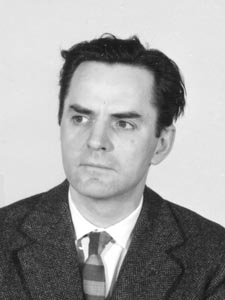
Alfred Russell was an artist who was a member of the early New York school of Abstract Expressionism. He exhibited in Paris and New York along with such well known painters as Willem de Kooning, Jackson Pollock, Ad Reinhardt and Mark Rothko. Later in life, Russell, disillusioned with abstraction, turned to figurative painting, with inspiration from the classical world.
Boston Expressionism is an arts movement marked by emotional directness, dark humor, social and spiritual themes, and a tendency toward figuration strong enough that Boston Figurative Expressionism is sometimes used as an alternate term to distinguish it from abstract expressionism, with which it overlapped.
References
- ↑ Who's Who in the World. Marquis Who's Who. 1970. p. 519. ISBN 9780837911014 . Retrieved February 19, 2023.
- 1 2 "Jonah Kinigstein". Smithsonian American Art Museum. Retrieved September 2, 2022.
- ↑ Young America 1957. Whitney Museum of American Art. 1957. p. 45. Retrieved September 15, 2022.
- 1 2 3 4 5 6 7 8 9 10 11 12 13 14 15 16 17 Schuerman, Matthew (January 1, 2023). "This artist stayed figurative when art went abstract — he's finally recognized, at 99". NPR. Retrieved January 3, 2023.
- 1 2 "Jonah Kinigstein". AskArt. Retrieved September 2, 2022.
- ↑ "Galerie Huit American Artists in Paris 1950-52 Catalog". Worthpoint. Retrieved September 2, 2022.
- ↑ "Jonah Kinigstein MoMA". The Museum of Modern Art. Retrieved September 2, 2022.
- ↑ "Jonah Kinigstein". Whitney Museum of American Art. Retrieved September 2, 2022.
- ↑ "Meet the artist who just turned 100 years old — and is finally having his moment". NPR. Retrieved July 22, 2023.
- ↑ "Jonah Kinigstein". National Academy of Design. Retrieved September 2, 2022.
- ↑ Kinigstein, Jonah (2014). The Emperor's new clothes : the Tower of Babel in the "art" world. Seattle, Washington: Fantagraphics.
- ↑ Kinigstein, Jonah (2022). Unrepentant artist : the paintings of Jonah Kinigstein. Seattle, WA: Fantagraphics. ISBN 9781683965411.